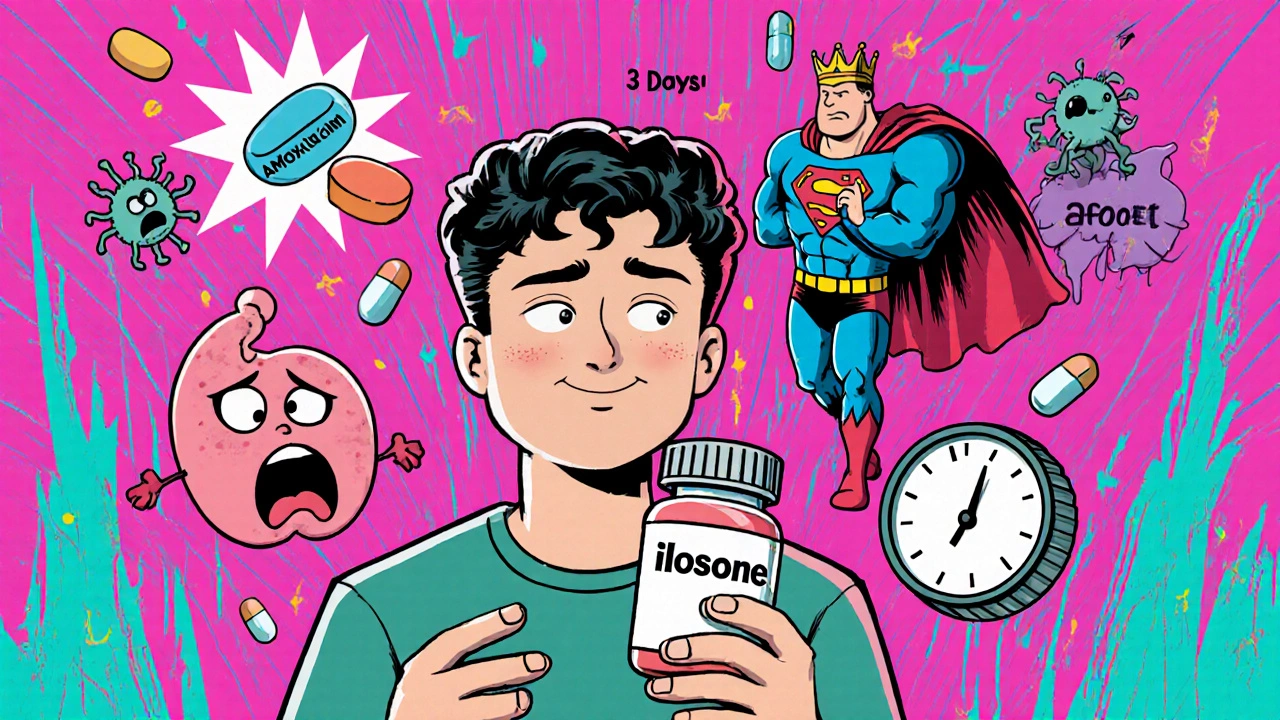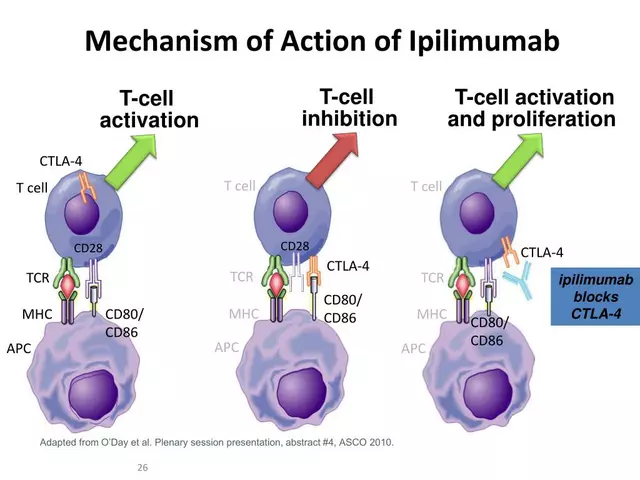Antibiotic Comparison Tool
Choose Your Situation
When your doctor prescribes Ilosone, you’re getting erythromycin - a classic antibiotic that’s been around since the 1950s. It’s not flashy, but it still works for many common infections. Still, you might wonder: are there better options now? Maybe cheaper ones? Or ones with fewer side effects? You’re not alone. People ask this every day, especially when they’ve had a bad reaction or heard about newer drugs.
What is Ilosone (Erythromycin) really used for?
Ilosone, the brand name for erythromycin, is a macrolide antibiotic that blocks bacteria from making proteins they need to survive. It’s not a first-line choice for everything anymore, but it’s still a go-to for specific cases.
Doctors still prescribe it for:
- Strep throat when you’re allergic to penicillin
- Whooping cough (pertussis) in kids and adults
- Skin infections like cellulitis or acne
- Respiratory infections in people who can’t take other antibiotics
- Preventing rheumatic fever in those with a history of it
It’s also used off-label for stomach motility issues - it can speed up digestion, which is why some people with gastroparesis take it. But that’s not its main job.
Why look at alternatives to Ilosone?
Even though erythromycin works, it’s not perfect. Many people stop taking it because of side effects. Up to 30% of users report nausea, vomiting, or stomach cramps. It also interacts with other drugs - like statins or blood thinners - which can be dangerous.
Plus, bacteria are getting better at resisting it. In some places, over half of strep throat strains are now resistant to erythromycin. That’s why doctors often pick something else first.
Amoxicillin: The Most Common Alternative
If you’re not allergic to penicillin, amoxicillin is a penicillin-based antibiotic that kills bacteria by breaking down their cell walls. It’s the top choice for strep throat, ear infections, and sinus infections.
Here’s how it stacks up against Ilosone:
| Feature | Amoxicillin | Ilosone (Erythromycin) |
|---|---|---|
| Best for | Strep throat, ear infections, sinusitis | Penicillin-allergic patients, whooping cough, acne |
| Common side effects | Mild diarrhea, rash | Nausea, vomiting, stomach pain |
| Drug interactions | Few | Many - statins, warfarin, some heart meds |
| Cost (30-day supply) | $5-$15 | $20-$50 |
| Resistance rate (strep throat) | Under 5% in most areas | Up to 50% in some regions |
Amoxicillin is cheaper, better tolerated, and more effective against common bugs. Unless you’re allergic to penicillin, it’s usually the smarter pick.

Azithromycin: The Popular Macrolide Replacement
If you need a macrolide - like Ilosone - but want something better, azithromycin (Zithromax) is the most common upgrade. It’s in the same drug family but designed to be more reliable.
Here’s why it beats erythromycin:
- Shorter course - often just 3 to 5 days instead of 7 to 14
- Less stomach upset - only 10-15% of users report nausea
- Better absorption - doesn’t need to be taken on an empty stomach
- Stronger against some respiratory bugs
It’s now the go-to for community-acquired pneumonia, bronchitis, and certain STIs like chlamydia. But it’s not perfect. Azithromycin has been linked to a small risk of irregular heart rhythms, especially in older adults or those with heart conditions.
For most people under 65 without heart issues, azithromycin is a safer, more convenient choice than Ilosone.
Clarithromycin: The Stronger Macrolide
Clarithromycin is another macrolide, similar to azithromycin but with a longer track record for treating stomach ulcers caused by H. pylori. It’s also used for sinus infections and pneumonia.
Compared to Ilosone:
- More effective against H. pylori - often paired with proton pump inhibitors
- Higher blood levels - means less frequent dosing
- Still causes stomach upset, but less than erythromycin
- More drug interactions than azithromycin - especially with blood thinners
It’s not usually the first choice for simple infections, but if you have a stubborn sinus infection or need to treat H. pylori, clarithromycin is often the macrolide of choice.
What about doxycycline or cephalexin?
Not all alternatives are macrolides. If you’re looking beyond that family, two other common options are:
Doxycycline - a tetracycline antibiotic. It’s great for acne, Lyme disease, and some respiratory infections. It’s cheaper than erythromycin and taken once or twice a day. But it can’t be used by kids under 8 or pregnant women because it stains developing teeth.
Cephalexin - a first-generation cephalosporin. It’s used for skin infections, urinary tract infections, and bone infections. It’s safe for most people, including kids, and has fewer interactions than Ilosone. But if you’re allergic to penicillin, there’s a 10% chance you’re allergic to cephalexin too.

When should you stick with Ilosone?
Even with all these alternatives, Ilosone still has its place:
- You have a confirmed penicillin allergy and can’t take amoxicillin or cephalexin
- You’re treating whooping cough and azithromycin isn’t available
- Your doctor needs to use it for gastroparesis (off-label use)
- You’re in a region where resistance to other antibiotics is high, but erythromycin still works
It’s also sometimes used in children who can’t swallow pills - it comes in liquid form, and some formulations taste better than others.
What about cost and insurance?
Generic erythromycin is cheaper than brand-name Ilosone, but even the generic version costs more than amoxicillin or doxycycline. In New Zealand, a 10-day course of erythromycin might cost $30-$45 with a prescription. Azithromycin, even as a generic, often runs $40-$60. Amoxicillin? Around $10.
Insurance plans usually favor amoxicillin or doxycycline as first-line options. If your doctor prescribes Ilosone, you might need prior authorization - especially if you don’t have a documented penicillin allergy.
What’s the bottom line?
Don’t assume Ilosone is the best choice just because it was prescribed. Ask your doctor: "Is there a simpler, cheaper, or better-tolerated option?" For most people, amoxicillin or azithromycin will do the job better.
Only stick with Ilosone if:
- You’re allergic to penicillin
- You’re treating a specific infection it’s proven for
- No other option is safe or available
Antibiotics aren’t interchangeable. Using the wrong one can lead to treatment failure, longer illness, or even antibiotic resistance. Always finish your full course - no matter which one you take.
Is Ilosone the same as erythromycin?
Yes. Ilosone is a brand name for the antibiotic erythromycin. The active ingredient is identical. Generic erythromycin works the same way and costs less.
Can I switch from Ilosone to azithromycin on my own?
No. Even though azithromycin is often a better option, you shouldn’t switch antibiotics without talking to your doctor. Dosing, duration, and safety depend on your specific infection, age, and health history. Self-switching can lead to treatment failure or side effects.
Why does Ilosone upset my stomach so much?
Erythromycin irritates the gut lining and speeds up stomach contractions, which can cause nausea, cramps, and diarrhea. This happens because it binds to receptors in the digestive tract. Azithromycin and clarithromycin were designed to avoid this, which is why they’re better tolerated.
Is erythromycin still effective for strep throat?
In many places, yes - but less reliably than before. Resistance rates have climbed to over 50% in some countries. Amoxicillin is still the most effective first choice for strep throat, unless you’re allergic to penicillin.
Can I take Ilosone if I’m pregnant?
Yes. Erythromycin is considered safe during pregnancy and is often used to treat infections like chlamydia or group B strep in pregnant women. It doesn’t harm the baby and is preferred over some other antibiotics in this group.
What’s the most common mistake people make with Ilosone?
Taking it with food. Erythromycin is absorbed better on an empty stomach - usually 1 hour before or 2 hours after meals. Taking it with food reduces its effectiveness. Many people don’t know this and wonder why the treatment isn’t working.




Bryan Heathcote
October 29, 2025 AT 12:04Ilosone still has its uses, but honestly, most docs prescribe it out of habit, not science. Azithromycin is just better in every way except cost-and even that’s changing as generics flood the market. Why make patients suffer nausea for no reason?
Rose Macaulay
October 29, 2025 AT 20:54I took Ilosone for acne years ago and barely made it through the first day. My stomach felt like it was being stabbed with a spoon. Switched to doxycycline and never looked back. Also, it didn’t make me want to cry every time I ate.
Anna S.
October 31, 2025 AT 14:46People don’t realize antibiotics aren’t candy. You take what your doctor gives you, finish the whole bottle, and shut up. If you want to play pharmacist, go med school.
Sam Tyler
November 1, 2025 AT 20:57There’s a real gap here between clinical guidelines and real-world prescribing. Amoxicillin should be first-line everywhere, but insurance formularies and outdated protocols keep erythromycin alive. It’s not about what works-it’s about what’s in the formulary. And yes, that’s a systemic problem. We need better education for both providers and patients. Antibiotic stewardship isn’t just a buzzword; it’s the difference between a treatable infection and a superbug nightmare.
KC Liu
November 1, 2025 AT 23:34Interesting how the article never mentions that Big Pharma pushed azithromycin as a ‘better’ alternative because it’s more profitable. Shorter courses mean more repeat prescriptions. Erythromycin is cheap, safe, and has been used for 70 years-why are we abandoning it because of a few stomach complaints? The real enemy is profit-driven medicine, not the antibiotic itself.
Milind Caspar
November 2, 2025 AT 23:59Let’s be honest: the entire medical establishment is a cartel. Erythromycin’s resistance rates are inflated because labs are incentivized to report resistance to justify expensive alternatives. Azithromycin? It’s been linked to 12,000 cardiac deaths in the last decade, but you won’t see that in the pamphlets. They’re replacing one problem with a more profitable one. Don’t trust the system. Question everything.
Prema Amrita
November 3, 2025 AT 15:14For strep throat in kids, amoxicillin is king. But if you're allergic and live in rural India, Ilosone is often the only affordable option. Don't judge the tool-judge the system that makes it necessary.
Vasudha Menia
November 5, 2025 AT 11:08My mom took Ilosone during her pregnancy for group B strep and it saved my life. No side effects, no drama. 🙏 So please don’t trash it entirely-it’s a lifeline for so many of us. ❤️
Michael Harris
November 6, 2025 AT 00:49Of course you’re gonna have stomach issues-it’s a macrolide. You think antibiotics are herbal tea? If you can’t handle a little nausea, maybe you shouldn’t be taking antibiotics at all. Grow up.
Ellen Frida
November 7, 2025 AT 18:35But… what if the stomach pain is actually your soul rejecting modern medicine? Like, maybe your body knows erythromycin is ancient and pure, and azithromycin is just… synthetic soul-sucking corporate magic? 🤔
Shanice Alethia
November 7, 2025 AT 21:06OMG I CANNOT BELIEVE YOU’RE STILL DEFENDING ILOSONE. IT’S A 1950s TERROR. I GOT HOSPITALIZED FROM IT. MY STOMACH WAS ON FIRE FOR THREE DAYS. AZITHROMYCIN IS THE ONLY REASON I’M STILL ALIVE. WHY DO YOU HATE HEALTH?
Robert Burruss
November 8, 2025 AT 18:06It’s not about which drug is ‘better’-it’s about context. A 72-year-old with atrial fibrillation shouldn’t get azithromycin. A child with a penicillin allergy needs something. A rural clinic in Nepal can’t afford to stock five different antibiotics. The real question isn’t ‘which antibiotic?’ but ‘who gets to decide?’ And who’s left out of that decision?
Alex Rose
November 9, 2025 AT 15:43Macrolide resistance is a classic example of selective pressure dynamics in microbial evolution. Erythromycin’s suboptimal pharmacokinetics and widespread empirical use have driven erm gene expression in Streptococcus pyogenes. Amoxicillin retains >95% efficacy in most regions due to lower usage pressure and bactericidal mechanism. The data is unequivocal.
shridhar shanbhag
November 10, 2025 AT 09:50In India, Ilosone is still used because it's cheap and works if you take it right. But people don't know to take it empty stomach. They eat paratha with it. Of course it fails. Education matters more than new drugs.
Mim Scala
November 12, 2025 AT 02:12My grandfather took erythromycin in ‘62 for pneumonia and lived to 98. He never even knew what a pharmacy was. Maybe we’re overcomplicating this. Sometimes the old ways are still the right ones.